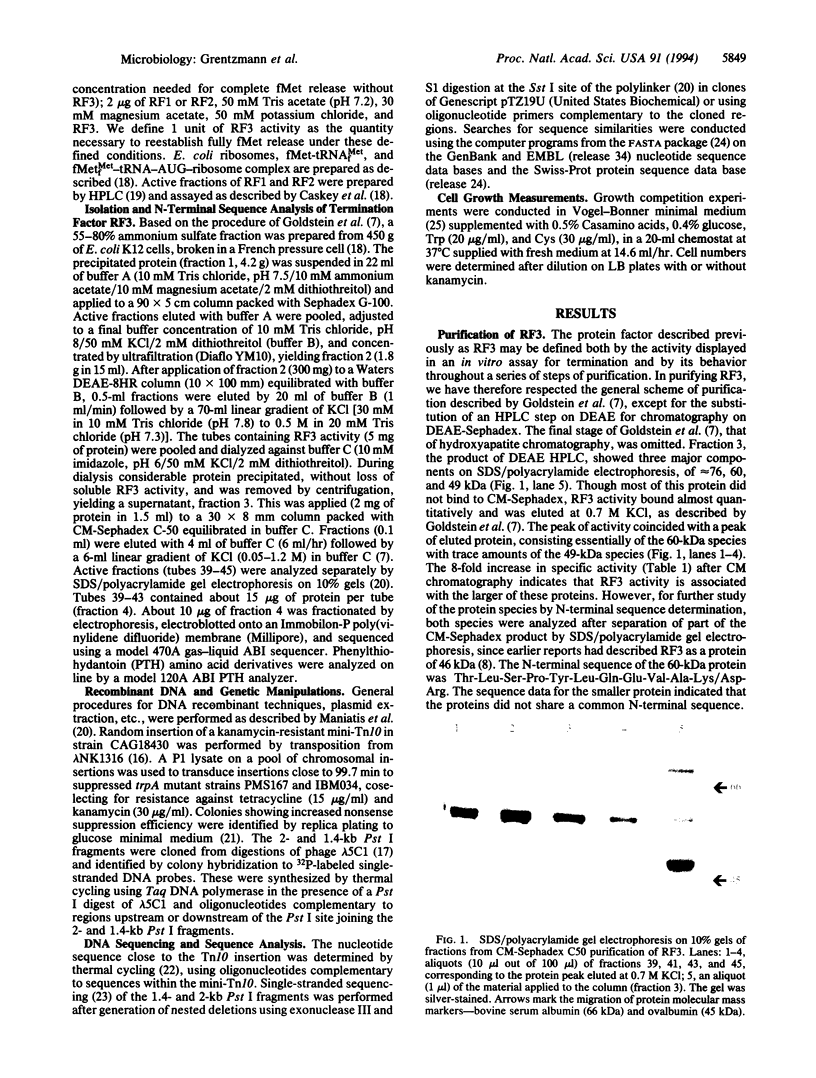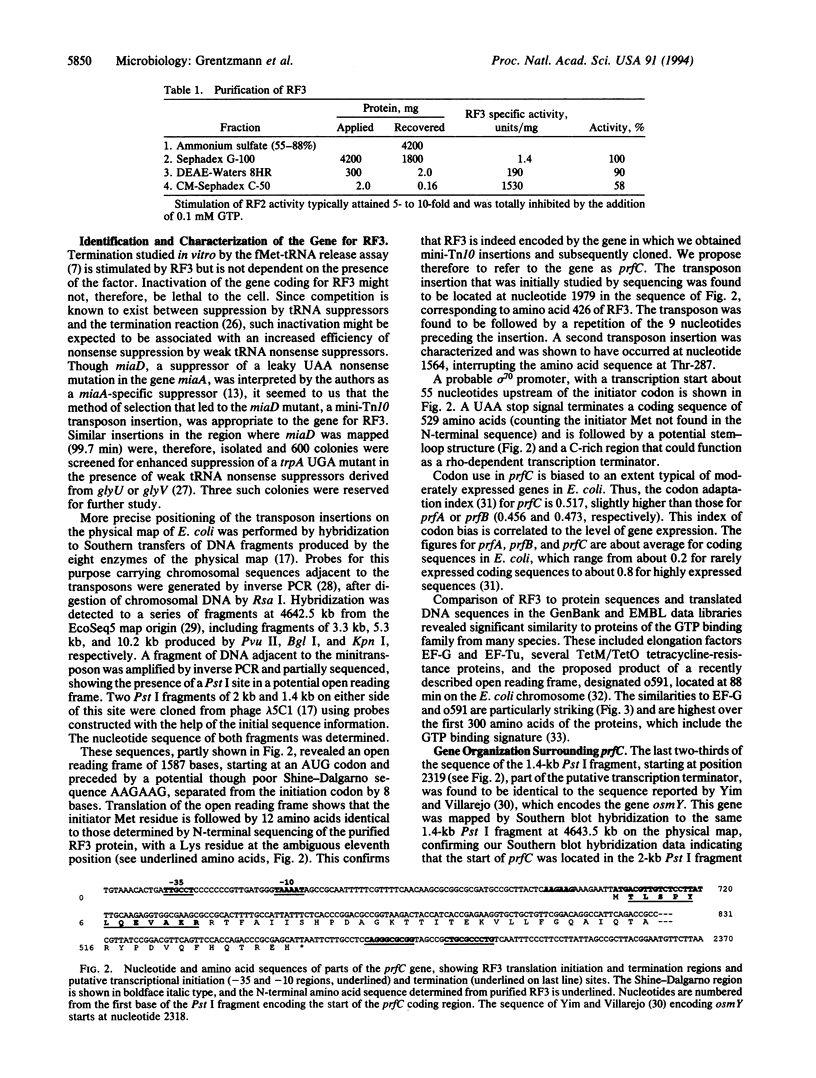Abstract
Two protein release factors (RFs) showing codon specificity, RF1 and RF2, are known to be required for polypeptide chain termination in Escherichia coli. A third protein component has also been described that stimulates termination in vitro, but it has remained uncertain whether this protein, RF3, participates in termination in vivo or is essential to cell growth. We report (i) the purification and N-terminal sequencing of RF3; (ii) the isolation of transposon insertion mutants similar to miaD, a suppressor of a leaky UAA mutation affecting the gene miaA, leading to enhanced nonsense suppression; (iii) the localization of the affected gene on the physical map of the chromosome; and (iv) the cloning and sequencing of the wild-type gene, providing proof that it encodes the factor RF3. We designate the gene prfC. Two transposon insertions were shown to interrupt the coding sequence of prfC, at codons 287 and 426. The enhanced nonsense suppression in the insertion mutants shows that the product participates in termination in vivo. The isolation of such mutants strongly suggests that the gene product is not essential to cell viability, though cell growth is affected. RF3 is a protein with a molecular weight of 59,460 containing 528 amino acids and displays much similarity to elongation factor EF-G, a GTP binding protein necessary for ribosomal translocation, and other GTP binding proteins known or thought to interact with the ribosome.
Full text
PDF




Images in this article
Selected References
These references are in PubMed. This may not be the complete list of references from this article.
- Bourne H. R., Sanders D. A., McCormick F. The GTPase superfamily: conserved structure and molecular mechanism. Nature. 1991 Jan 10;349(6305):117–127. doi: 10.1038/349117a0. [DOI] [PubMed] [Google Scholar]
- Buckingham K., Chung D. G., Neilson T., Ganoza M. C. Recognition of translational termination signals. Biochim Biophys Acta. 1987 Jul 14;909(2):92–98. doi: 10.1016/0167-4781(87)90030-3. [DOI] [PubMed] [Google Scholar]
- Buckingham R. H., Sörensen P., Pagel F. T., Hijazi K. A., Mims B. H., Brechemier-Baey D., Murgola E. J. Third position base changes in codons 5' and 3' adjacent UGA codons affect UGA suppression in vivo. Biochim Biophys Acta. 1990 Aug 27;1050(1-3):259–262. doi: 10.1016/0167-4781(90)90177-4. [DOI] [PubMed] [Google Scholar]
- Capecchi M. R. Polypeptide chain termination in vitro: isolation of a release factor. Proc Natl Acad Sci U S A. 1967 Sep;58(3):1144–1151. doi: 10.1073/pnas.58.3.1144. [DOI] [PMC free article] [PubMed] [Google Scholar]
- Carter J. R., Franden M. A., Aebersold R., McHenry C. S. Identification, isolation, and overexpression of the gene encoding the psi subunit of DNA polymerase III holoenzyme. J Bacteriol. 1993 Sep;175(17):5604–5610. doi: 10.1128/jb.175.17.5604-5610.1993. [DOI] [PMC free article] [PubMed] [Google Scholar]
- Connolly D. M., Winkler M. E. Structure of Escherichia coli K-12 miaA and characterization of the mutator phenotype caused by miaA insertion mutations. J Bacteriol. 1991 Mar;173(5):1711–1721. doi: 10.1128/jb.173.5.1711-1721.1991. [DOI] [PMC free article] [PubMed] [Google Scholar]
- Craigen W. J., Cook R. G., Tate W. P., Caskey C. T. Bacterial peptide chain release factors: conserved primary structure and possible frameshift regulation of release factor 2. Proc Natl Acad Sci U S A. 1985 Jun;82(11):3616–3620. doi: 10.1073/pnas.82.11.3616. [DOI] [PMC free article] [PubMed] [Google Scholar]
- Ganoza M. C. Polypeptide chain termination in cell-free extracts of E. coli. Cold Spring Harb Symp Quant Biol. 1966;31:273–278. doi: 10.1101/sqb.1966.031.01.035. [DOI] [PubMed] [Google Scholar]
- Gesteland R. F., Weiss R. B., Atkins J. F. Recoding: reprogrammed genetic decoding. Science. 1992 Sep 18;257(5077):1640–1641. doi: 10.1126/science.1529352. [DOI] [PubMed] [Google Scholar]
- Goldstein J., Milman G., Scolnick E., Caskey T. Peptide chain termination. VI. Purification and site of action of S. Proc Natl Acad Sci U S A. 1970 Feb;65(2):430–437. doi: 10.1073/pnas.65.2.430. [DOI] [PMC free article] [PubMed] [Google Scholar]
- Kawakami K., Jönsson Y. H., Björk G. R., Ikeda H., Nakamura Y. Chromosomal location and structure of the operon encoding peptide-chain-release factor 2 of Escherichia coli. Proc Natl Acad Sci U S A. 1988 Aug;85(15):5620–5624. doi: 10.1073/pnas.85.15.5620. [DOI] [PMC free article] [PubMed] [Google Scholar]
- Kleckner N., Bender J., Gottesman S. Uses of transposons with emphasis on Tn10. Methods Enzymol. 1991;204:139–180. doi: 10.1016/0076-6879(91)04009-d. [DOI] [PubMed] [Google Scholar]
- Kohara Y., Akiyama K., Isono K. The physical map of the whole E. coli chromosome: application of a new strategy for rapid analysis and sorting of a large genomic library. Cell. 1987 Jul 31;50(3):495–508. doi: 10.1016/0092-8674(87)90503-4. [DOI] [PubMed] [Google Scholar]
- Lee C. C., Kohara Y., Akiyama K., Smith C. L., Craigen W. J., Caskey C. T. Rapid and precise mapping of the Escherichia coli release factor genes by two physical approaches. J Bacteriol. 1988 Oct;170(10):4537–4541. doi: 10.1128/jb.170.10.4537-4541.1988. [DOI] [PMC free article] [PubMed] [Google Scholar]
- McCaughan K. K., Ward C. D., Trotman C. N., Tate W. P. The ribosomal binding domain for the bacterial release factors RF-1, RF-2 and RF-3. FEBS Lett. 1984 Sep 17;175(1):90–94. doi: 10.1016/0014-5793(84)80576-1. [DOI] [PubMed] [Google Scholar]
- Milman G., Goldstein J., Scolnick E., Caskey T. Peptide chain termination. 3. Stimulation of in vitro termination. Proc Natl Acad Sci U S A. 1969 May;63(1):183–190. doi: 10.1073/pnas.63.1.183. [DOI] [PMC free article] [PubMed] [Google Scholar]
- Moazed D., Robertson J. M., Noller H. F. Interaction of elongation factors EF-G and EF-Tu with a conserved loop in 23S RNA. Nature. 1988 Jul 28;334(6180):362–364. doi: 10.1038/334362a0. [DOI] [PubMed] [Google Scholar]
- Murgola E. J., Hijazi K. A., Göringer H. U., Dahlberg A. E. Mutant 16S ribosomal RNA: a codon-specific translational suppressor. Proc Natl Acad Sci U S A. 1988 Jun;85(12):4162–4165. doi: 10.1073/pnas.85.12.4162. [DOI] [PMC free article] [PubMed] [Google Scholar]
- Murgola E. J. tRNA, suppression, and the code. Annu Rev Genet. 1985;19:57–80. doi: 10.1146/annurev.ge.19.120185.000421. [DOI] [PubMed] [Google Scholar]
- Murray V. Improved double-stranded DNA sequencing using the linear polymerase chain reaction. Nucleic Acids Res. 1989 Nov 11;17(21):8889–8889. doi: 10.1093/nar/17.21.8889. [DOI] [PMC free article] [PubMed] [Google Scholar]
- Ochman H., Gerber A. S., Hartl D. L. Genetic applications of an inverse polymerase chain reaction. Genetics. 1988 Nov;120(3):621–623. doi: 10.1093/genetics/120.3.621. [DOI] [PMC free article] [PubMed] [Google Scholar]
- Pearson W. R., Lipman D. J. Improved tools for biological sequence comparison. Proc Natl Acad Sci U S A. 1988 Apr;85(8):2444–2448. doi: 10.1073/pnas.85.8.2444. [DOI] [PMC free article] [PubMed] [Google Scholar]
- Plunkett G., 3rd, Burland V., Daniels D. L., Blattner F. R. Analysis of the Escherichia coli genome. III. DNA sequence of the region from 87.2 to 89.2 minutes. Nucleic Acids Res. 1993 Jul 25;21(15):3391–3398. doi: 10.1093/nar/21.15.3391. [DOI] [PMC free article] [PubMed] [Google Scholar]
- Rudd K. E., Miller W., Ostell J., Benson D. A. Alignment of Escherichia coli K12 DNA sequences to a genomic restriction map. Nucleic Acids Res. 1990 Jan 25;18(2):313–321. doi: 10.1093/nar/18.2.313. [DOI] [PMC free article] [PubMed] [Google Scholar]
- Ryden M., Murphy J., Martin R., Isaksson L., Gallant J. Mapping and complementation studies of the gene for release factor 1. J Bacteriol. 1986 Dec;168(3):1066–1069. doi: 10.1128/jb.168.3.1066-1069.1986. [DOI] [PMC free article] [PubMed] [Google Scholar]
- Salyers A. A., Speer B. S., Shoemaker N. B. New perspectives in tetracycline resistance. Mol Microbiol. 1990 Jan;4(1):151–156. doi: 10.1111/j.1365-2958.1990.tb02025.x. [DOI] [PubMed] [Google Scholar]
- Sanger F., Nicklen S., Coulson A. R. DNA sequencing with chain-terminating inhibitors. Proc Natl Acad Sci U S A. 1977 Dec;74(12):5463–5467. doi: 10.1073/pnas.74.12.5463. [DOI] [PMC free article] [PubMed] [Google Scholar]
- Scolnick E., Tompkins R., Caskey T., Nirenberg M. Release factors differing in specificity for terminator codons. Proc Natl Acad Sci U S A. 1968 Oct;61(2):768–774. doi: 10.1073/pnas.61.2.768. [DOI] [PMC free article] [PubMed] [Google Scholar]
- Sharp P. M., Li W. H. The codon Adaptation Index--a measure of directional synonymous codon usage bias, and its potential applications. Nucleic Acids Res. 1987 Feb 11;15(3):1281–1295. doi: 10.1093/nar/15.3.1281. [DOI] [PMC free article] [PubMed] [Google Scholar]
- Singer M., Baker T. A., Schnitzler G., Deischel S. M., Goel M., Dove W., Jaacks K. J., Grossman A. D., Erickson J. W., Gross C. A. A collection of strains containing genetically linked alternating antibiotic resistance elements for genetic mapping of Escherichia coli. Microbiol Rev. 1989 Mar;53(1):1–24. doi: 10.1128/mr.53.1.1-24.1989. [DOI] [PMC free article] [PubMed] [Google Scholar]
- Stöffler G., Cundliffe E., Stöffler-Meilicke M., Dabbs E. R. Mutants of Escherichia coli lacking ribosomal protein L11. J Biol Chem. 1980 Nov 10;255(21):10517–10522. [PubMed] [Google Scholar]
- Tate W. P., Brown C. M. Translational termination: "stop" for protein synthesis or "pause" for regulation of gene expression. Biochemistry. 1992 Mar 10;31(9):2443–2450. doi: 10.1021/bi00124a001. [DOI] [PubMed] [Google Scholar]
- Tate W. P., Dognin M. J., Noah M., Stöffler-Meilicke M., Stöffler G. The NH2-terminal domain of Escherichia coli ribosomal protein L11. Its three-dimensional location and its role in the binding of release factors 1 and 2. J Biol Chem. 1984 Jun 10;259(11):7317–7324. [PubMed] [Google Scholar]
- Tate W. P., Hornig H., Lührmann R. Recognition of termination codon by release factor in the presence of a tRNA-occupied A site. Evidence for flexibility in accommodation of the release factor on the ribosome. J Biol Chem. 1983 Sep 10;258(17):10360–10365. [PubMed] [Google Scholar]
- Tate W. P., Kastner B., Edgar C. D., McCaughan K. K., Timms K. M., Trotman C. N., Stoffler-Meilicke M., Stoffler G., Nag B., Traut R. R. The ribosomal domain of the bacterial release factors. The carboxyl-terminal domain of the dimer of Escherichia coli ribosomal protein L7/L12 located in the body of the ribosome is important for release factor interaction. Eur J Biochem. 1990 Feb 14;187(3):543–548. doi: 10.1111/j.1432-1033.1990.tb15335.x. [DOI] [PubMed] [Google Scholar]
- Tucker S. D., Murgola E. J., Hijazi K. A. Reversion of trpA nonsense mutations by deletion of the chain-termination codons. Biochimie. 1989 Jun;71(6):721–728. doi: 10.1016/0300-9084(89)90088-6. [DOI] [PubMed] [Google Scholar]
- VOGEL H. J., BONNER D. M. Acetylornithinase of Escherichia coli: partial purification and some properties. J Biol Chem. 1956 Jan;218(1):97–106. [PubMed] [Google Scholar]
- Weiss R. B., Murphy J. P., Gallant J. A. Genetic screen for cloned release factor genes. J Bacteriol. 1984 Apr;158(1):362–364. doi: 10.1128/jb.158.1.362-364.1984. [DOI] [PMC free article] [PubMed] [Google Scholar]
- Yim H. H., Villarejo M. osmY, a new hyperosmotically inducible gene, encodes a periplasmic protein in Escherichia coli. J Bacteriol. 1992 Jun;174(11):3637–3644. doi: 10.1128/jb.174.11.3637-3644.1992. [DOI] [PMC free article] [PubMed] [Google Scholar]
- Yoshikawa A., Isono S., Sheback A., Isono K. Cloning and nucleotide sequencing of the genes rimI and rimJ which encode enzymes acetylating ribosomal proteins S18 and S5 of Escherichia coli K12. Mol Gen Genet. 1987 Oct;209(3):481–488. doi: 10.1007/BF00331153. [DOI] [PubMed] [Google Scholar]



